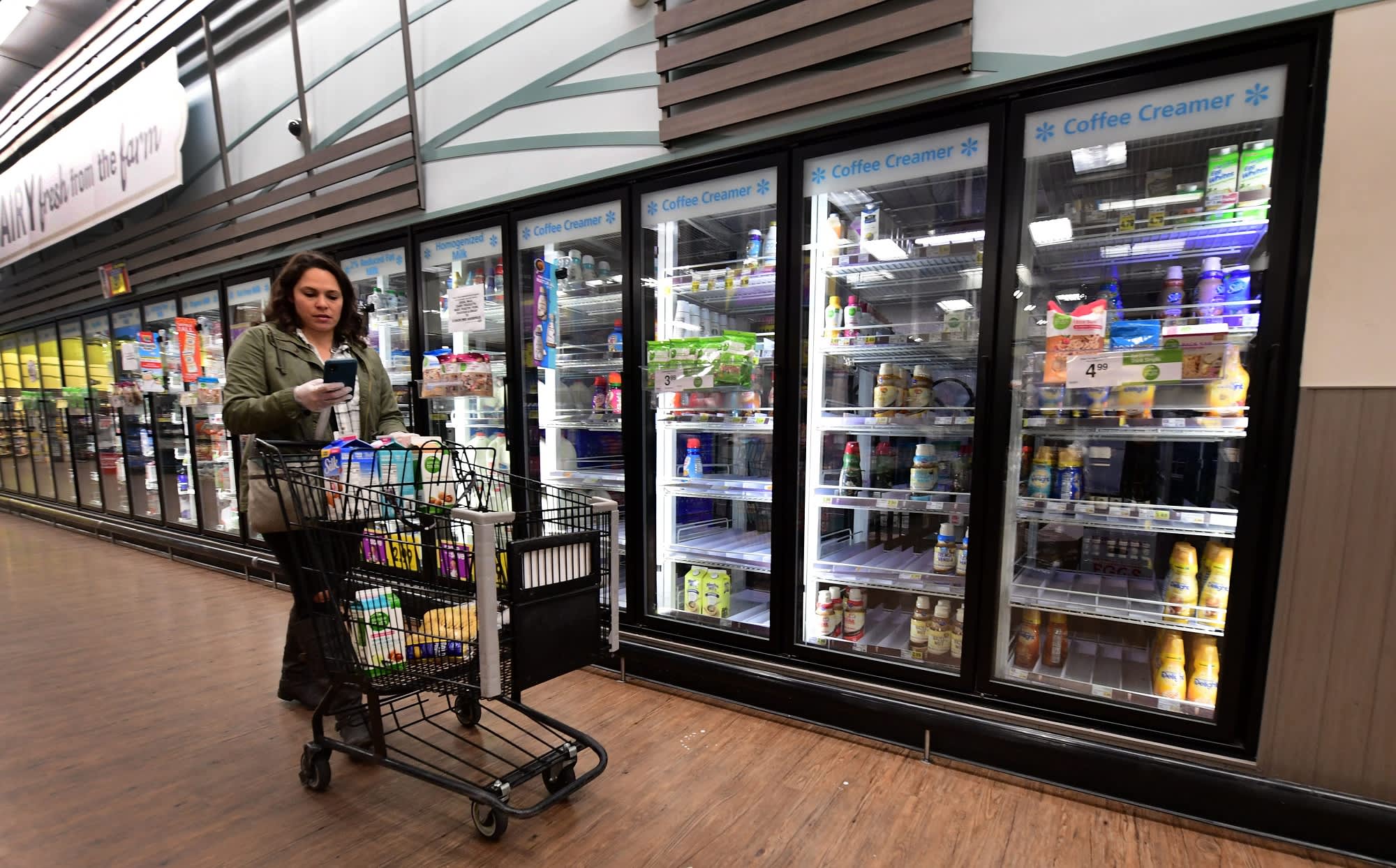
Gone are the days of leisurely browsing the aisles of grocery stores.
Instead, customers are getting used to new grocery store fixtures: Mask-wearing employees, plexiglass barriers at cash registers, one-way aisles and antibacterial wipe dispensers. Some of those will become the norm. Others will fade away as coronavirus cases decline. But many analysts predict the pandemic will change how customers stock their fridges and pantries and shape their expectations in the months or years ahead.
Here’s a round-up of five changes sparked by the pandemic:
No touching, please
Getty Images
Customers are more squeamish about germs — and that could linger.
Grocers and other retailers have touted new and expanded contactless approaches to shop or check out. Walmart, for example, added a new feature to its smartphone app that allows customers to scan a QR code instead of touching a screen at the cash register. Other apps, such as Apple Pay and Google Pay, also allow customers to skip the credit card reader.
With curbside pickup, customers can pop the trunk instead of going into stores. Some retailers have waived the need for a signature when people pick up groceries or get a delivery to their home.
Some customers are opting for prepackaged goods, as they skip the deli counter and other parts of the store with additional food handling, said Jill Standish, Accenture’s global head of retail. She said the grab-and-go items also shorten shoppers’ time in stores, another common preference.
Those approaches may stick because of their convenience, along with heightened safety.
‘Go local’ trend on steroids
Produce at an Arkansas farmer’s market
dlewis33 | iStock | Getty Images
Long before the pandemic, customers bought fruits and vegetables at farmers markets and supported local businesses, such as cheese shops. The pandemic is accelerating that trend, said Scott McKenzie, Nielsen’s head of global intelligence.
Now, he said, people gravitate even more to products grown or made closer to home. They’re thinking about the long distances that produce, meat and other foods may travel and the borders they may cross before arriving to their kitchen table — and the many people who may touch them along the way.
That’s driving more interest in subscriptions to farm boxes and items with “a shorter supply chain,” McKenzie said.
“I call this the phenomenon of buying milk from cows you can see,” he said.
Shift to online shopping accelerates
Getty Images
Grocery shoppers have downloaded new grocery apps and tried new online services. Those discoveries have shaken up habits and could lead to a meaningful shift in an industry that’s been slow to go digital.
Customers have used third-party delivery services, such as Instacart, FreshDirect and Target-owned Shipt, to get groceries. They’ve also ordered online and used curbside or in-store pickup at Walmart and Target.
Only about 3% or 4% of grocery spending in the U.S. was online before the coronavirus outbreak, according to research by consulting firm Bain & Company. That could increase to between 5% and 10% after it, said Steve Caine, a retail expert and partner for the firm.
A personal touch by ‘pickers’
Instacart employee Monica Ortega checks her cellphone for orders while picking up groceries from a supermarket for delivery on March 19, 2020 in North Hollywood, California.
Frederic J. Brown | AFP via Getty Images
Grocers will look for creative ways to strengthen relationships with customers and entice them to add more to their virtual baskets, as more customers shop online in addition to in-store.
Employees who fulfill and bag online orders at stores — often called pickers or shoppers — will become increasingly important and could become a competitive advantage for retailers, said Eiko Kawano, a group experience director for digital consulting firm, Publicis Sapient.
Grocers may use the employees as brand ambassadors and suggestive sellers, she said. Stores could ask pickers to upload a photo or a brief profile and allow customers to rate the pickers like Uber and Lyft drivers. Through a combination of personal relationships and algorithms, the shopper or picker could personalize customers’ orders by recommending an item. And they could nudge customers towards higher margin items and discretionary purchases, too.
The rise of the robot
Humanoid robot “Prepper” stands on April 2, 2020 at the cash desk of a supermarket of the Edeka retail chain in Lindlar, Germany, to explain protective measures and to promote solidarity with each other, amid the novel coronavirus / COVID-19 pandemic.
Ina Fassbender | AFP | Getty Images
Out-of-stock items and hard-to-find delivery or curbside pickup slots have revealed some grocers’ pain points. That may inspire stepped-up investments in automation, especially as grocers compete with behemoths like Amazon and Walmart.
Some grocers are turning unused space in the back of grocery stores into small-scale, automated distribution centers that speed up and reduce the price of fulfilling online orders. The technique is called micro-fulfillment.
One company that sells the automated systems, New York-based Fabric, said more grocers have expressed interest in the systems or have sped up their projects during the pandemic, said Steve Hornyak, the company’s chief commercial officer. He said the systems resemble giant vending machines.
The pandemic may inspire more innovation and experimentation with “dark stores,” which fulfill only pickup and delivery orders. Kroger, for example, turned one of the stores near its Cincinnati headquarters into pickup-only in late March.
Customers have been more willing to wait for an available delivery slot and more flexible delivery times since they’re stuck at home, said Standish, who works for Accenture.
Grocers must adapt quickly, though, since their patience will wane, she said: “Consumers might say ‘I’m not going to wait another week. Let me go somewhere else.'”



